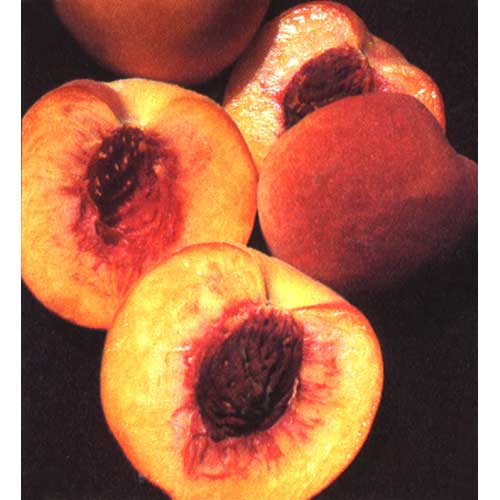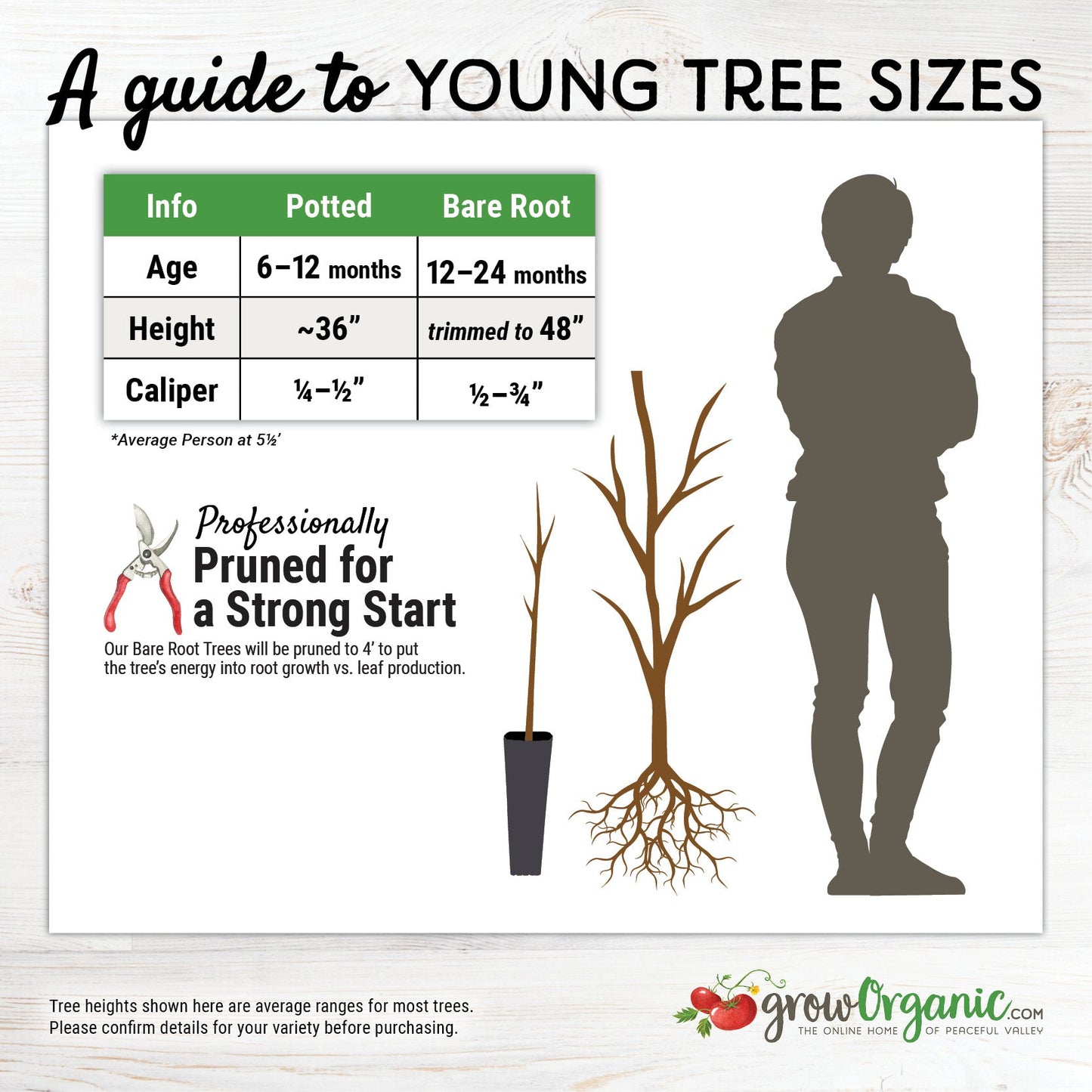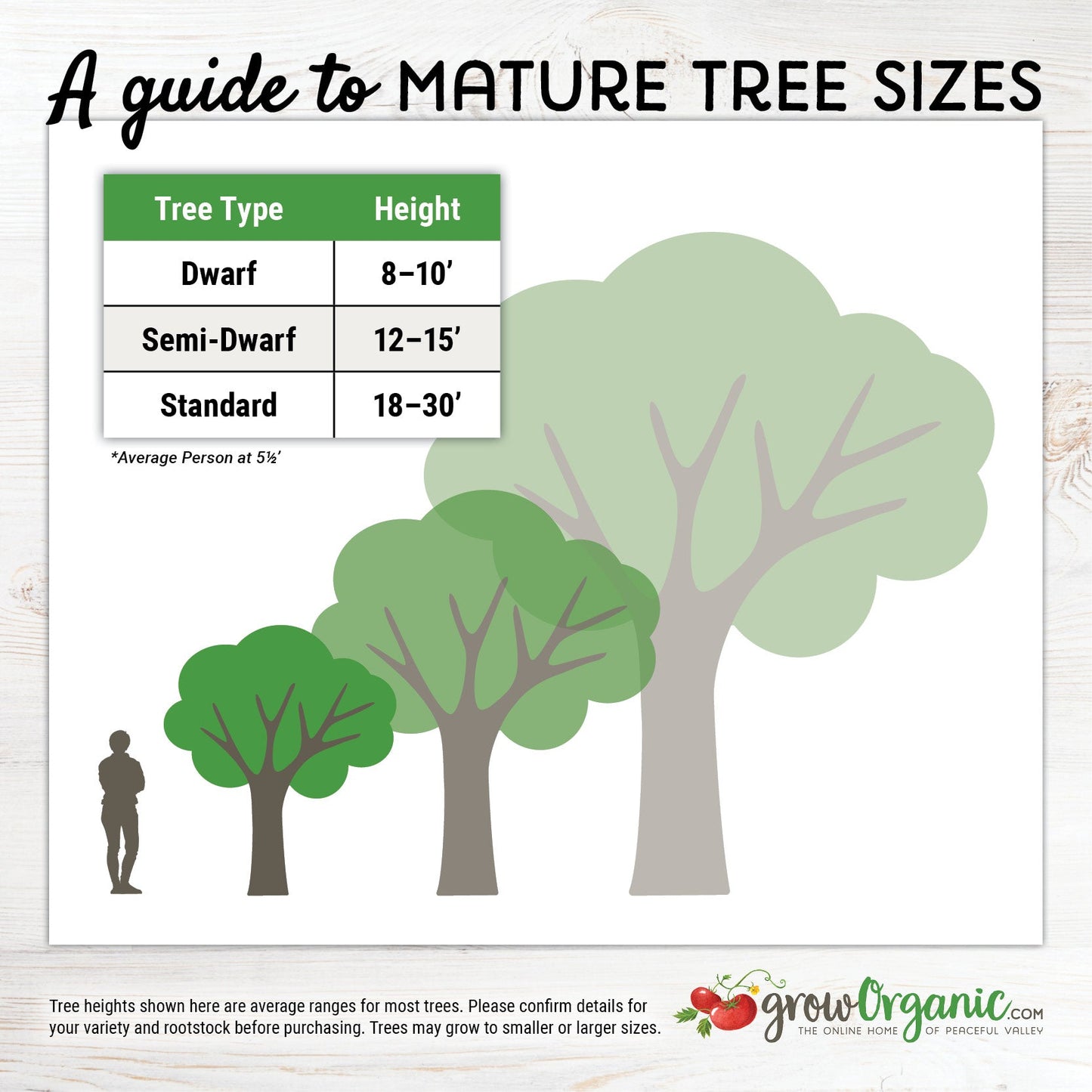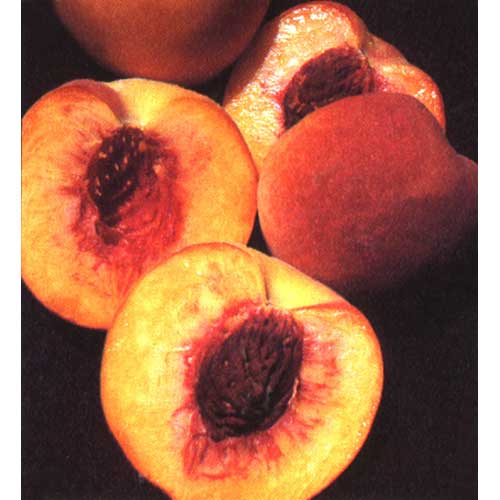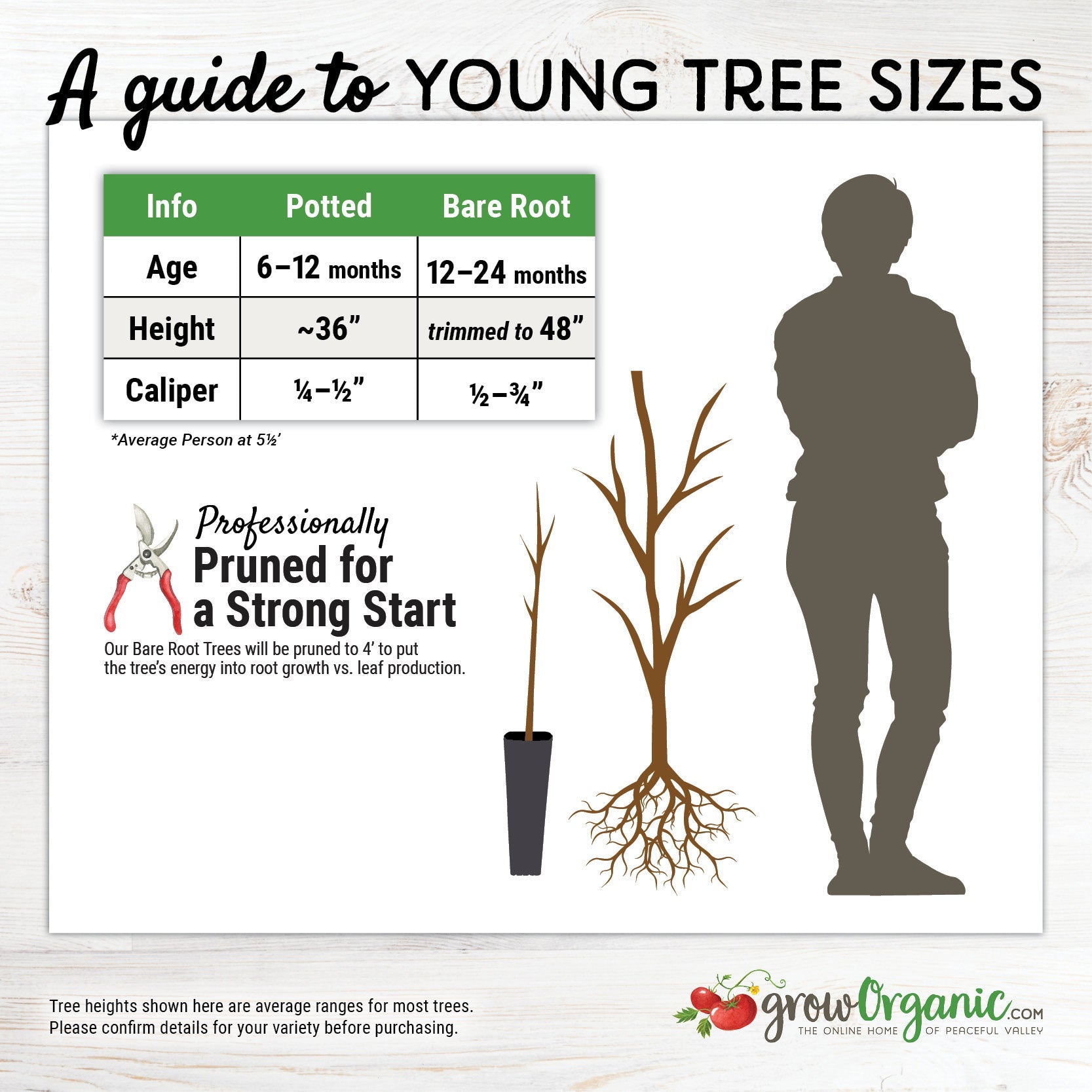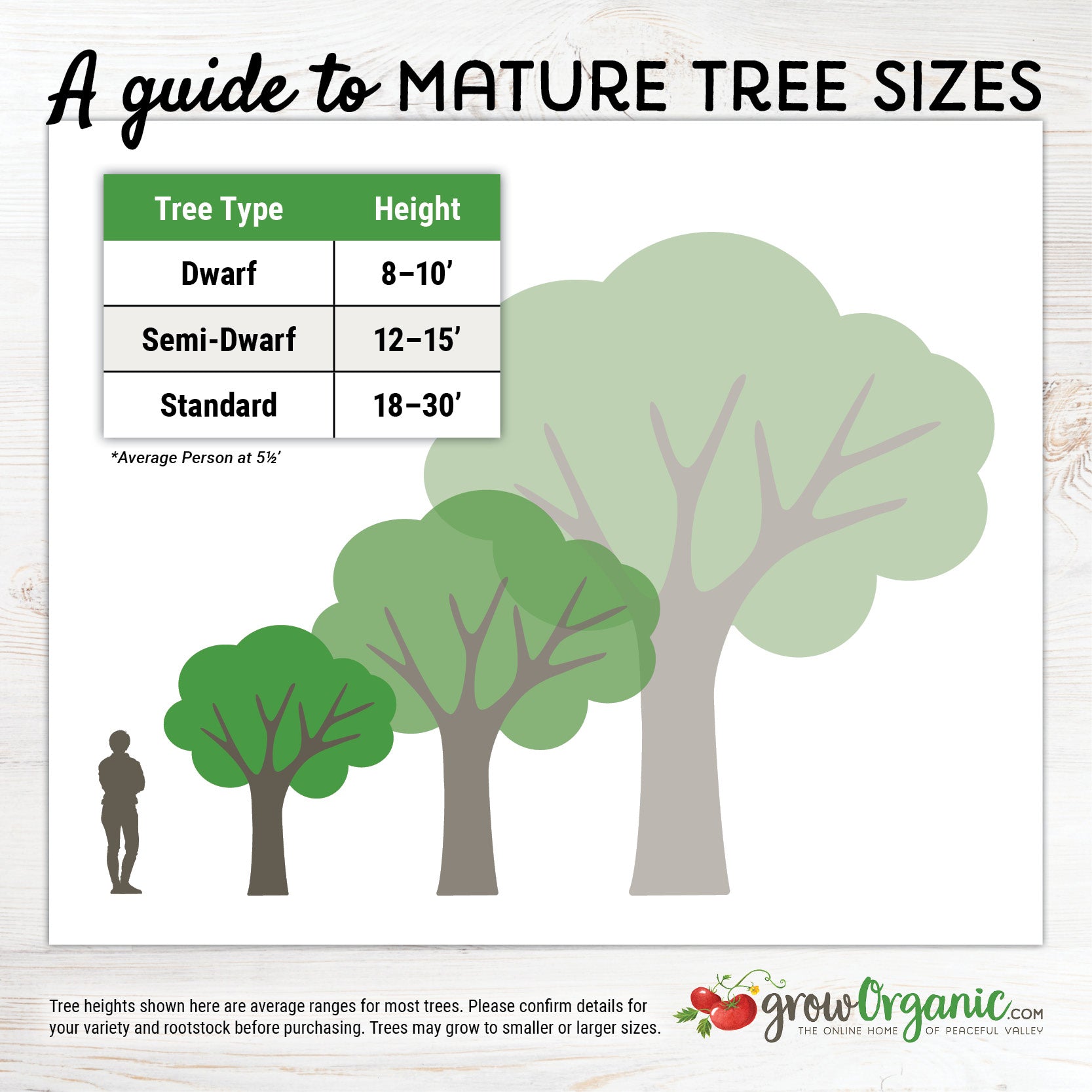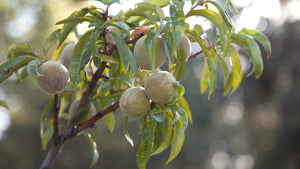Item Number: FT159
Loring Peach Tree
Loring Peach Tree
Great Choice for Cold Areas
Semi-dwarf on Citation rootstock.
- Zones: 6-9
- Chill hours: 750
- Bloom Time: Late Mid-Season (Based on typical Central Valley California weather)
- Harvest: July 15 - August 1
- Looks: Large, yellow freestone.
- Personality: Excellent flavor and texture, with low acidity.
- Facts of note: Dave Wilson's Taste Test Top Scorer. Favorite in colder regions. Superb, flavor taste test winner. Requires little or no thinning making it an excellent choice for the home orchard.
- Pollination: Self-fruitful.
The Loring Peach tree, scientifically known as Prunus persica, is a beloved and highly sought-after fruit tree among orchard enthusiasts. Known for its exceptionally sweet and juicy peaches, the Loring Peach tree is a favorite for fresh eating, canning, and baking.
Characteristics of the Loring Peach Tree:
Fruit: The Loring Peach is renowned for its large, round to slightly oblong fruits. These peaches have a vibrant orange-yellow skin with a red blush on the side exposed to the sun. The flesh is juicy, melting, and incredibly sweet, making it a delightful treat for peach lovers.
Flavor Profile: The Loring Peach is celebrated for its exceptional sweetness and rich flavor. It offers a perfect balance of sugar and acidity, creating a mouthwatering taste that is both refreshing and satisfying.
Ripening Time: Loring Peaches typically ripen in mid to late summer, providing a bountiful harvest during this warm and sunny season.
Tree Size: Loring Peach trees are semi-dwarf, reaching a height of around 10 to 15 feet when mature. This manageable size makes them suitable for smaller orchards and home gardens.
Pollination: Loring Peach trees are self-pollinating, meaning they can produce fruit without the need for another peach tree nearby. However, having multiple peach trees can increase fruit production and diversity.
Cultivating Loring Peach Trees:
Location: Plant your Loring Peach tree in a location with full sun exposure, as they thrive in bright, direct sunlight. Adequate sunlight ensures the development of flavorful and sweet peaches.
Soil: Loring Peach trees prefer well-draining, loamy soil with a slightly acidic to neutral pH level. Ensure proper soil drainage to prevent waterlogged roots.
Planting: It's best to plant Loring Peach trees in late winter or early spring, while they are dormant. Provide adequate spacing of at least 12 to 15 feet between trees to allow for proper air circulation and growth.
Watering: Newly planted trees require regular watering to establish their root systems. Once established, maintain consistent moisture levels, especially during dry periods, to support fruit development.
Pruning: Prune your Loring Peach tree during the dormant season to shape the tree, remove dead or diseased branches, and improve air circulation. Proper pruning helps maintain a healthy and productive tree.
Thinning: As the peaches on your Loring Peach tree begin to develop, thin them out to allow proper spacing between fruits. This practice ensures larger, healthier peaches and prevents overcrowding.
Culinary Uses of Loring Peaches:
Fresh Eating: Loring Peaches are a true delight when enjoyed fresh. Their sweet, juicy, and aromatic flesh makes them perfect for snacking, adding to fruit salads, or incorporating into desserts.
Canning: Due to their exceptional flavor and juiciness, Loring Peaches are a popular choice for canning. Preserve their goodness by canning peach slices, halves, or making peach preserves.
Baking: Loring Peaches are versatile for baking. Use them in pies, cobblers, crisps, muffins, and cakes to infuse your baked goods with their delightful sweetness and texture.
Sauces: Create flavorful peach sauces for glazing meats, enhancing barbecue dishes, or drizzling over ice cream and pancakes.
Freezing: Freeze sliced Loring Peaches to enjoy their flavor and nutrition year-round. Frozen peaches are perfect for smoothies and as a topping for cereals and yogurt.
The Loring Peach tree is a prized addition to any orchard or home garden, offering a bounty of sweet and juicy peaches during the summer months. With proper care and attention to its cultivation, you can savor the exquisite taste of Loring Peaches in various culinary creations or enjoy them fresh off the tree. The Loring Peach tree not only brings delicious rewards but also adds beauty and vibrancy to your outdoor space.
Visit our Fruit Tree Central for a listing of all our fruit tree videos and articles.
Visit Tree Characteristics for a listing of all our fruit & nut tree growing characteristics.


Check Your Zone Compatibility:
Compatible with your zone.
Growing Zone for
,

Our Guarantee To You
Since 1976, we've served our customers at every stage of growing. Please contact us at any time. We are happy to support and assist you.
Description
Description
Semi-dwarf on Citation rootstock.
- Zones: 6-9
- Chill hours: 750
- Bloom Time: Late Mid-Season (Based on typical Central Valley California weather)
- Harvest: July 15 - August 1
- Looks: Large, yellow freestone.
- Personality: Excellent flavor and texture, with low acidity.
- Facts of note: Dave Wilson's Taste Test Top Scorer. Favorite in colder regions. Superb, flavor taste test winner. Requires little or no thinning making it an excellent choice for the home orchard.
- Pollination: Self-fruitful.
The Loring Peach tree, scientifically known as Prunus persica, is a beloved and highly sought-after fruit tree among orchard enthusiasts. Known for its exceptionally sweet and juicy peaches, the Loring Peach tree is a favorite for fresh eating, canning, and baking.
Characteristics of the Loring Peach Tree:
Fruit: The Loring Peach is renowned for its large, round to slightly oblong fruits. These peaches have a vibrant orange-yellow skin with a red blush on the side exposed to the sun. The flesh is juicy, melting, and incredibly sweet, making it a delightful treat for peach lovers.
Flavor Profile: The Loring Peach is celebrated for its exceptional sweetness and rich flavor. It offers a perfect balance of sugar and acidity, creating a mouthwatering taste that is both refreshing and satisfying.
Ripening Time: Loring Peaches typically ripen in mid to late summer, providing a bountiful harvest during this warm and sunny season.
Tree Size: Loring Peach trees are semi-dwarf, reaching a height of around 10 to 15 feet when mature. This manageable size makes them suitable for smaller orchards and home gardens.
Pollination: Loring Peach trees are self-pollinating, meaning they can produce fruit without the need for another peach tree nearby. However, having multiple peach trees can increase fruit production and diversity.
Cultivating Loring Peach Trees:
Location: Plant your Loring Peach tree in a location with full sun exposure, as they thrive in bright, direct sunlight. Adequate sunlight ensures the development of flavorful and sweet peaches.
Soil: Loring Peach trees prefer well-draining, loamy soil with a slightly acidic to neutral pH level. Ensure proper soil drainage to prevent waterlogged roots.
Planting: It's best to plant Loring Peach trees in late winter or early spring, while they are dormant. Provide adequate spacing of at least 12 to 15 feet between trees to allow for proper air circulation and growth.
Watering: Newly planted trees require regular watering to establish their root systems. Once established, maintain consistent moisture levels, especially during dry periods, to support fruit development.
Pruning: Prune your Loring Peach tree during the dormant season to shape the tree, remove dead or diseased branches, and improve air circulation. Proper pruning helps maintain a healthy and productive tree.
Thinning: As the peaches on your Loring Peach tree begin to develop, thin them out to allow proper spacing between fruits. This practice ensures larger, healthier peaches and prevents overcrowding.
Culinary Uses of Loring Peaches:
Fresh Eating: Loring Peaches are a true delight when enjoyed fresh. Their sweet, juicy, and aromatic flesh makes them perfect for snacking, adding to fruit salads, or incorporating into desserts.
Canning: Due to their exceptional flavor and juiciness, Loring Peaches are a popular choice for canning. Preserve their goodness by canning peach slices, halves, or making peach preserves.
Baking: Loring Peaches are versatile for baking. Use them in pies, cobblers, crisps, muffins, and cakes to infuse your baked goods with their delightful sweetness and texture.
Sauces: Create flavorful peach sauces for glazing meats, enhancing barbecue dishes, or drizzling over ice cream and pancakes.
Freezing: Freeze sliced Loring Peaches to enjoy their flavor and nutrition year-round. Frozen peaches are perfect for smoothies and as a topping for cereals and yogurt.
The Loring Peach tree is a prized addition to any orchard or home garden, offering a bounty of sweet and juicy peaches during the summer months. With proper care and attention to its cultivation, you can savor the exquisite taste of Loring Peaches in various culinary creations or enjoy them fresh off the tree. The Loring Peach tree not only brings delicious rewards but also adds beauty and vibrancy to your outdoor space.
Visit our Fruit Tree Central for a listing of all our fruit tree videos and articles.
Visit Tree Characteristics for a listing of all our fruit & nut tree growing characteristics.
Extremely vigorous trees requiring regular pruning and thinning. Needs fertile, well drained soils. Tend to bloom early and may be difficult to crop in late frost areas. Plant several varieties for continued supply, as ripe fruit does not store well. Susceptible to peach leaf curl, brown rot, oriental fruit moth and peach twig borer. Trees are 2 years old and should begin to fruit in their 3rd year. Browse all our peach trees for sale.
Citation Rootstock is tolerant of wet soil, induces early dormancy in dry soil, is very winter hardy, resists root knot nematodes, and produces a 12'-18' tree. By pruning you can keep your tree at any height.
Please Note: Although most of our bare-root trees arrive to our warehouse in mid-December, there are a few varieties that will not arrive until mid-January. If you order any of those varieties along with varieties that arrive in mid-December, your order will be delayed for shipment until mid-January. If you'd like us to split your shipments, please contact us at (888) 784-1722 or orderdesk@groworganic.com. Additional shipping charges will apply.
Shipping Information
Shipping Information
Cannot ship to the following states: HI, AK, PR, GU, VI
Cannot ship via USPS.
Cannot ship via SmartPost.
Shipping Weight: 5.0 lb
Dimensions: 55.5"L x 7.3"W x 2.75"H
Features
Features
- Flavor Pick
- Freestone
- Self-fruitful
- Suited to Cold Climates
Characteristics
Characteristics
Planting & Care
Planting & Care
Useful Information
Useful Information
Guarantee
Guarantee
Limited Dormant Tree & Plant Guarantee
* Claim deadline is June 15th
We guarantee that your dormant tree or plant will arrive in good, viable condition. If your tree arrives in substandard condition, notify us within 3 days of delivery. Please email pictures of the box, inside packaging, the tree and its roots to helpdesk@groworganic.com. We will investigate your claim and process a request to exchange or refund the damaged product.
If your dormant tree or plant has not grown new leaves by June 15th, you may be eligible for our Limited Dormant Tree & Plant Guarantee. This guarantee provides for a store credit for the purchase price of the tree, excluding shipping. Please see the Instructions below.
Important Dates:
- April 1st Dormant trees/plants must be planted in the ground
- May 15th Perform scratch test, if no new leaves have grown
- June 15th Deadline to apply for a dormant tree/plant credit
All required documentation must be received by June 15th for your claim to be considered. Claims or documentation received after June 15th will be denied, without exception. Instructions listed below
Terms and Conditions
We cannot guarantee that your tree or plant will remain alive and healthy after it is received, or bear fruit as there are too many variables in your environment that are beyond our control (i.e. soil preparation, weed and pest control, proper irrigation, chill hours, compatible hardiness for your growing zone, proper choice of pollinator, extreme weather, rodent damage, disease, etc.).
We cannot guarantee that we will be able to provide a replacement tree/plant of the same species either that same growing season or in future years. Customers are responsible for all shipping fees associated with replacement trees and plants.
If we determine that the tree you purchased directly from us is not viable, we will issue you a store credit (not a refund) for the purchase price of the affected dormant tree or plant. Shipping is not included in the dormant tree/plant guarantee. Store credits can be used to purchase any product we sell and are valid for use only until July 1st of the following year.
Historically, 98% of our dormant trees and plants grow and thrive when they have been cared for and planted using our growing guides. Dormant trees and plants must be planted in the ground by April 1st in order to be eligible for credit. If the ground in your area is still frozen solid, you may temporarily plant your tree or plant in a pot.
Potted, non-dormant trees or plants are excluded from this guarantee as they are not dormant at the time of shipment. Evergreen trees such as citrus, avocado and olive trees are not available for credit under the Dormant Tree and Plant Guarantee.
Instructions
We guarantee that your dormant fruit tree or plant will leaf out, if you care for it according to our growing guides. In the unlikely event that your dormant tree or plant does not have leaves by May 15th, follow these simple steps to apply for a store credit:
Before you call or email, please perform a “scratch test” to determine if the tree or plant is still alive. This video shows how to check for live tissue under the bark. Scratch tests need to be done a few inches above and below the graft.
Green Cambium Layer / Living Trees
If the cambium layer under the bark is green, give your tree a little more time. It is still alive, but hasn’t come out of dormancy yet. Check to make sure that it is getting the right amount of deep root water, enough sunlight and that the weather is warm enough for that type of tree/plant to come out of dormancy. Every tree has its own personality and will come out of dormancy at different times. Be sure to submit the required documentation listed below by June 15th, if it doesn’t grow leaves.
Brown Cambium Layer / Dead Trees
If the scratch test shows a brown cambium layer or if your dormant tree/plant doesn’t have leaves by June 1st, please email us at helpdesk@groworganic.com. All required documentation listed below must be received by June 15th for your claim to be considered. To be considered for the guarantee claim, all required documentation must be received by June 15th. Incomplete submissions will be denied.
Required Documentation
- Order number
- Name of dormant tree/plant and the quantity affected
- Photos of each tree or plant showing:
- The roots (tree or plant must be pulled out of the ground)
- The scratch test areas
- The entire tree/plant
We reserve the right to not issue credit for items that have already been replaced. We also reserve the right to require photographic evidence that the tree/plant was not killed by root rot, rodent or mechanical damage.
Share
